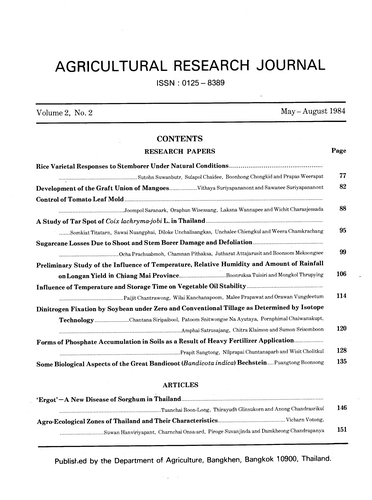Forms of Phosphate Accumulation in Soils as a Result of Heavy Fertilizer Application
Abstract
A study was undertaken of the fetility levels of soils in a vegetable growing area of Pathumthani province where there had been successive heavy annual applications of fertilizer including lime, over a number of years. A much higher level of fertility was found in the vegetable growing areas relative to rice paddy areas, particularly in relation to phosphate for which total phosphate levels were as much as ten times greater in the vegetable soils relative to the paddy soils. Both the relative importance of phoshpate forms and their levels varied under the two soil conditions. In both the vegetable producing and paddy soils the major form of phosphate was iron phosphate (Fe-P), although in absouute terms the level in the vegetable soils averaged almost 13 times greater (973 ppm) than in the paddy soils. Reductant phosphate (Re-P) was the second most important phosphate form in teh paddy soil but the least important in the vegetable soils; readily extractable phosphate (WE-P) was almost non-existent in the paddy soils but had levels averaging 45 ppm in the vegetable soils. Much higher levels of inorganic phosphate were also recorded in teh vegetable soils relative to the paddy soils as a result of continued fertiliser application to the former. It was concluded that further phosphate fertilizer application on the vegetable soils was unnecessary until there is a substantial reduction in phosphate levels.
Downloads
Published
How to Cite
Issue
Section
License
Thai Agricultural Research Journal



